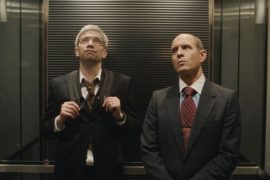It’s being billed as “The World’s First True Hollywood Story.” No, not Peter Jackson’s recent documentary epic “The Beatles Get Back,” or Aaron Sorkin’s upcoming look at Lucille Ball, “Being the Ricardos.”Saturday night on Showtime and Crave, go back 100 years and more with The Little Tramp in “The Real Charlie Chaplin.”
What was the world’s first movie star really like? Directors Peter Middleton and James Spinney attempt to answer that question with commentary, thanks to a Life magazine interview he gave in 1966, from Chaplin himself.
Many others, including actress-daughter Geraldine Chaplin, share insights into a guarded entertainer who seems both wildly charismatic and intensely private and insecure. The many months spent shooting a few scenes in “City Lights” (1931) demonstrates his obsessive and very personal filmmaking style. Also covered are the history lessons, including the Communist witch hunt accusations and personal scandals (of Chaplin’s four marriages, three were to teenagers) that helped drive “The Little Tramp” from America in 1951.
Chaplin’s story has ben told before. Kevin Browlow and David Gill’s tremendous 1983 documentary, “Unknown Chaplin,” made nearly 40 years ago, had the advantage of first-hand access to Chaplin’s second wife Lita Grey, his son Sydney Earl Chaplin, and his surviving co-stars Jackie Coogan, Dean Riesner, Georgia Hale, and Virginia Cherrill. That series also dug into the vault with unseen outtakes from Chaplin’s Mutual shorts and and some of his features, revealing the filmmaker’s exacting drive to get the perfect take and basically write as he filmed — costly scheduling delays be damned.
The new documentary puts more emphasis on Chaplin’s personal legacy and, frankly, not enough on the laughter he inspired. His penchant for marrying teens and a socialist bent that had him framed as a Communist sympathizer would likely not have survived today’s divided political climate, nor the current #metoo movement. Chaplin, seen as a cad after a messy paternity suit — an image downgrade not helped after he made a film playing a wife killer (1947’s “Monsieur Verdoux”) — became an easy target and a prize “get” in the ’50s for the House Un-American Activities Commitee. He spent 20 years in exhile in Europe before returning to America to accept a special Oscar in 1971. Chaplin died on Christmas Day, 1977, at 88.
Chaplin, the new film reminds us, was even more internationally famous and beloved than either Lucy or The Beatles, especially in the first decades of cinema. He is to be admired, as well, for retaining control of his films and keeping the original materials as pristine as possible. As with Jackson’s “Get Back,” it is incredible what modern technologies can do with, in the case of Chaplin, century-old film images. Seeing great artists in their prime through a clear lens makes these kind of documentary retrospectives must see every time, no matter how familiar the stories.
advertisement






